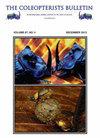Recognition of the Pseudocryptic Species Xylosandrus declivigranulatus (Schedl) as Distinct from Xylosandrus crassiusculus (Motschulsky) (Coleoptera: Curculionidae: Scolytinae: Xyleborini)
IF 0.8
4区 农林科学
Q3 ENTOMOLOGY
引用次数: 1
Abstract
Abstract Xylosandrus crassiusculus (Motschulsky, 1866) occupies worldwide temperate to tropical forests and suburban areas within its natural and non-native range as a result of human introductions. Given its pest status, several studies of population genetics have been conducted. As a result of an ongoing study, several smaller individuals from southern Thailand exhibited nucleotide differences that were dissimilar to the remaining individuals, thus calling into question the species status of these individuals. We performed a phylogenetic analysis of X. crassiusculus individuals from widely dispersed locations, including an individual from southern Thailand, and a robust sampling of other Xylosandrus Reitter, 1913 species using xyleborine diagnostic genes mtDNA COI and nucDNA CAD. The smaller individual from southern Thailand was sister to the remaining X. crassiusculus individuals and demonstrated >13% and >3% nucleotide difference in COI and CAD sequences, respectively. Upon the examination of type specimens, we confirmed that these smaller X. crassiusculus individuals were indeed Xylosandrus declivigranulatus (Schedl, 1936), status restored, which we resurrect. Its smaller size and pronotum as long as wide diagnose this pseudocryptic species from X. crassiusculus.伪隐种Xylosandrus declivigranulatus (sched1)与Xylosandrus crassiusculus (Motschulsky)的区别(鞘翅目:曲蝇科;鞘翅目:木蝇科)
摘要/ Abstract摘要:木sandrus crassiusculus (Motschulsky, 1866)由于人类的引种,在温带至热带的森林和郊区分布有木sandrus。鉴于其有害状况,已经进行了一些种群遗传学研究。由于一项正在进行的研究,来自泰国南部的几个较小的个体表现出与其他个体不同的核苷酸差异,因此对这些个体的物种地位提出了质疑。我们对来自广泛分布地点的X. crassiusculus个体进行了系统发育分析,包括来自泰国南部的个体,并使用木犀草碱诊断基因mtDNA COI和核dna CAD对其他Xylosandrus Reitter, 1913种进行了大量采样。来自泰国南部的较小个体是剩余的X. crassiusculus个体的姐妹,在COI和CAD序列上分别表现出>13%和>3%的核苷酸差异。通过对模式标本的检查,我们确认这些较小的X. crassiusculus个体确实是Xylosandrus declivigranulatus (Schedl, 1936),状态恢复,我们复活了它。其较小的尺寸和长而宽的前角可诊断为该伪隐种。
本文章由计算机程序翻译,如有差异,请以英文原文为准。
求助全文
约1分钟内获得全文
求助全文
来源期刊

Coleopterists Bulletin
生物-昆虫学
CiteScore
1.00
自引率
14.30%
发文量
73
期刊介绍:
Founded in 1947 by Ross H. Arnett, Jr., The Coleopterists Bulletin is a refereed quarterly journal, which includes a wide variety of articles on taxonomy and ecology of beetles (Coleoptera). Both members and non-members may submit manuscripts for consideration for publication.
 求助内容:
求助内容: 应助结果提醒方式:
应助结果提醒方式:


